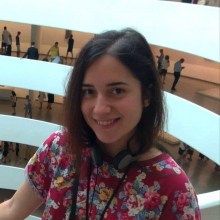Position Description
Υπερταχεία Φασματοσκοπία Περοβσκιτικών Φωτοβολταικών Διατάξεων
Για το πλήρες κείμενο της πρόσκλησης ακολουθήστε τον σύνδεσμο 'Related Documents'
Required Qualifications
- Διδακτορικό δίπλωμα στην Φυσική ή Επιστήμη Υλικών
- Εμπειρία στο αντικείμενο της θέσης
- Δημοσιεύσεις σχετικές με το αντικείμενο της θέσης
- Καλή γνώση της Αγγλικής γλώσσας
Application Procedure
Στο φάκελο υποβολής της πρότασης θα πρέπει να εμπεριέχονται τα ακόλουθα:
- Αίτηση (form Greek την αριστερή στήλη) με αναφορά στον κωδικό της θέσης και στο όνομα του προγράμματος
- Αναλυτικό Βιογραφικό Σημείωμα
- Ευκρινή φωτοαντίγραφα τίτλων σπουδών
Οι ενδιαφερόμενοι καλούνται να υποβάλουν τις αιτήσεις τους και όλα τα απαραίτητα δικαιολογητικά, ηλεκτρονικά στη διεύθυνση hr@iesl.forth.gr με κοινοποίηση (cc): στον Δρ Εμμ. Στρατάκη (stratak@iesl.forth.gr).
Οι αιτήσεις θα πρέπει να αποσταλούν με την ένδειξη: «Αίτηση στο πλαίσιο του προγράμματος PrintWin, της πρόσκλησης εκδήλωσης ενδιαφέροντος με Α.Π. … και κωδικό θέσης … » (όπως αυτός αναφέρεται στον Πίνακα του Παραρτήματος). Αντικατάσταση της πρότασης ή διόρθωση αυτής ή συμπλήρωση τυχόν ελλειπόντων δικαιολογητικών επιτρέπεται μόνο μέχρι τη λήξη της προθεσμίας υποβολής των προτάσεων.
Appointment Duration
6 μήνεςPosition Description
Θεωρητική μελέτη αλληλεπίδρασης ακτινοβολίας Λέιζερ με Νανοσωματίδια
Required Qualifications
- Διδακτορικό δίπλωμα στην Φυσική
- Εμπειρία στην θεωρητική μελέτη αλληλεπίδρασης ύλης-ακτινοβολίας
- Δημοσιεύσεις σχετικές με το αντικείμενο της θέσης
- Άριστη γνώση της Αγγλικής γλώσσας
Application Procedure
Οι ενδιαφερόμενοι καλούνται να υποβάλουν τις αιτήσεις τους και όλα τα απαραίτητα δικαιολογητικά, ηλεκτρονικά στη διεύθυνση hr@iesl.forth.gr με κοινοποίηση (cc): στον Δρ Εμμ. Στρατάκη (stratak@iesl.forth.gr).
Οι αιτήσεις θα πρέπει να αποσταλούν με την ένδειξη: «Αίτηση στο πλαίσιο της πρόσκλησης εκδήλωσης ενδιαφέροντος με Α.Π. … και κωδικό θέσης … » (όπως αυτός αναφέρεται στον Πίνακα του Παραρτήματος). Αντικατάσταση της πρότασης ή διόρθωση αυτής ή συμπλήρωση τυχόν ελλειπόντων δικαιολογητικών επιτρέπεται μόνο μέχρι τη λήξη της προθεσμίας υποβολής των προτάσεων.
Appointment Duration
6 μήνεςPosition Description
Required Qualifications
The required qualifications are graduate university degree in physics or related disciplines, and good command of the English language. Good theoretical background in quantum theory, as well as computer and programming skills, are desired.
Application Procedure
Interested candidates are encouraged to contact
Dr. David Petrosyan, email: dap@iesl.forth.gr tel: +30 2810 391131
Dr. Georgios Nikolopoulos, email: nikolg@iesl.forth.gr tel: +30 2810 391005
Appointment Duration
36 months
Evi Aspropotamiti joined our group as a diploma student, and she worked on quantum state discrimination, and some applications in a twin-field quantum key distribution protocol. In March 2020, she moved to the group of Prof. D. Psaltis, at EPFL in Lausanne, for post-graduate research.
Education
- 2020: B.Sc. in Physics, Department of Physics, University of Crete, Greece
Career
- 2020: Post-graduate research, EPFL, Lausanne, Switzerland
Interests
- Quantum Cryptography
Dr. Lukas F. Buchmann received his PhD degree in Physics from the University of Crete in 2010, having spent 3 years in our Group.
He then worked as a postdoctoral researcher at the University of Arizona (USA) and at the University of California, Berkeley (USA).
Between 2015 and 2017 Lukas was a joint research associate at Aarhus University (Denmark) and in our group. After staying
two more years at Aarhus University, Lukas went to Switzerland in 2019, where he is now a Senior Expert in Software and Optical
Measurements at FISBA AG.
Education
- 2010: PhD in Physics, Department of Physics, University of Crete, Greece
- 2007: M.Sc. in Elementary Particle Theory, University of Durham, Durham, England
- 2006: B.Sc. in Physics, University of Zurich, Zurich, Switzerland
Career
- 2015-2019 Research Associate, Aarhus University, Denmark
- 2013-2015 UC Berkeley, Berkeley, CA, Post-Doctoral Researcher
- 2010-2013 Post-Doctoral Researcher, University of Arizona, Tucson, AZ
Interests
- Quantum Technology & Metrology
- Quantum Optics
- Quantum/Classical Transition
- Nonlinear Phenomena
Awards/Prizes/Distinctions
- 2013-2015: SNSF Fellow



